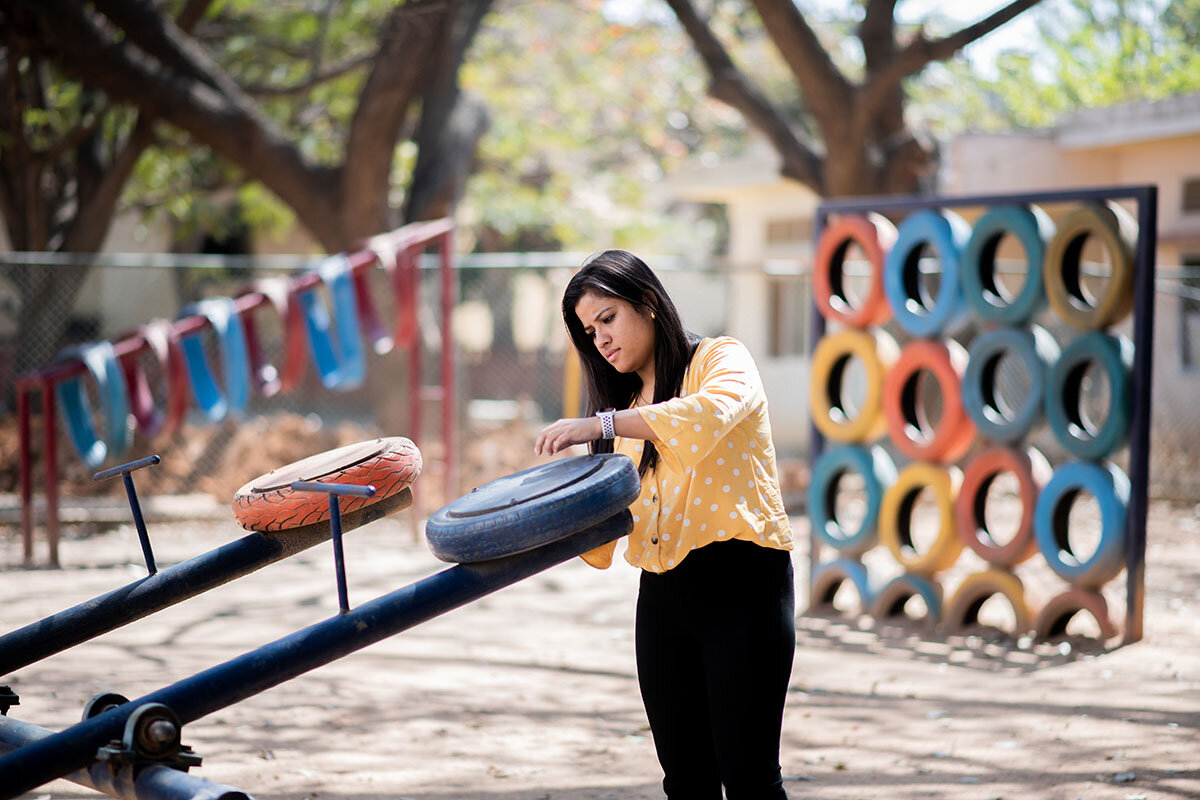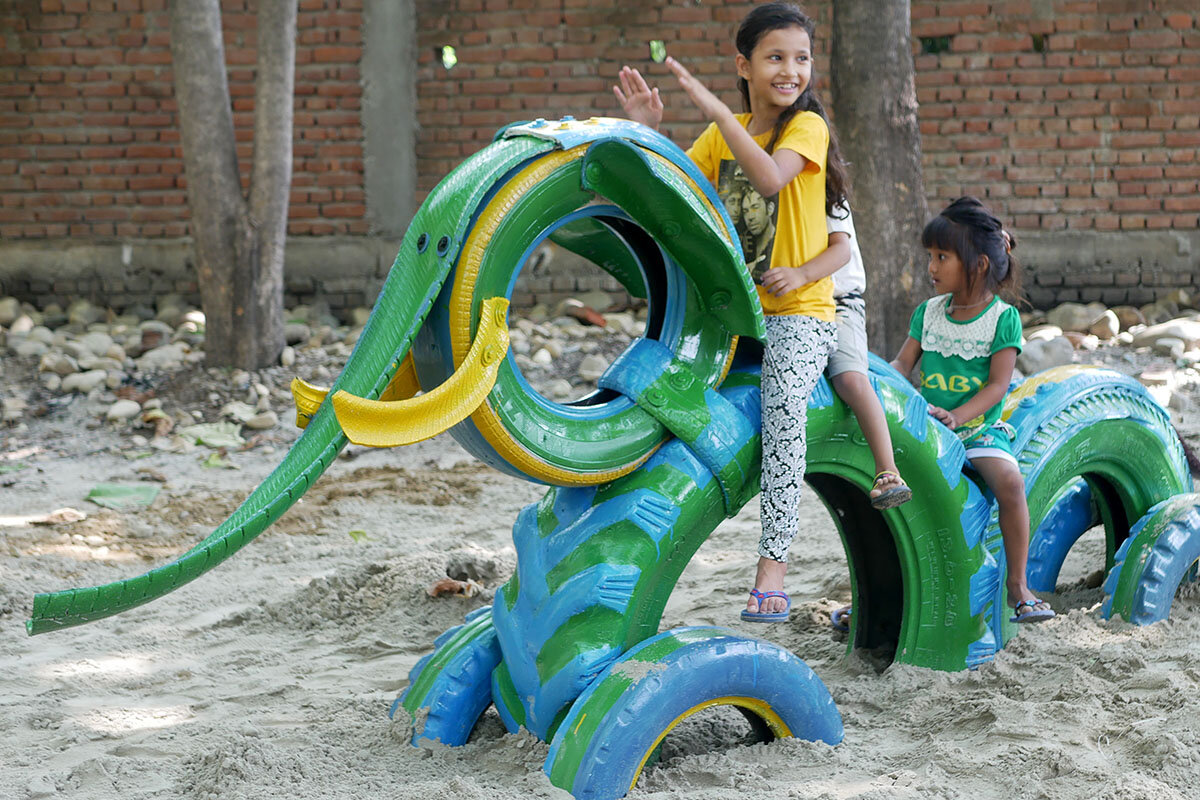India trashes 100 million tires a year. She turns them into playgrounds.
Loading...
| Mullipallam, India
A bright sun beats down in Mullipallam, a village some 250 miles from the southern Indian city of Bengaluru. Half a dozen teachers have gathered in a government-run primary school at the heart of the village, past winding dirt roads, a dried riverbed, grazing goats, and vast scrubland.
“It’s been a tough year,” admits principal KS Kanthamani. The blackboard behind her still is full of vivid drawings, but the room is bare and silent. During India’s lockdown last spring, students were “utterly isolated,” she says, since few have internet access here. Driven by poverty, some parents encouraged their children to take on odd jobs in packaging industries that dot the neighborhood.
Just when dropouts seemed inevitable, something rekindled children’s interest.
Why We Wrote This
It doesn’t take much to spark play. But it does take space – and some creativity. For this playground-building nonprofit, play is more than a child’s instinct. It’s a right.
Last October, the school decided to revamp its run-down playground. It engaged Anthill Creations, a nonprofit based in Bengaluru, to build a new one, assisted by donations from a local bank. The revamped play space is mostly built from brightly painted discarded tires, making it affordable. With two tire swings and a model motorcycle, it’s small – but welcome.
Second grader Srilekha Murlikrishnan says the blue tire swing is her favorite, much better than a regular swing. “I’m more flexible and can twist my body through the hole,” she giggles. “I come to school now just to play here every day, and I’m really looking forward to it reopening again.”
Anthill Creations is the brainchild of Pooja Rai, who’s motivated by how many parts of India lack public space for children. “We live in a world where play, such an essential part of growing up, is now viewed as a luxury and even thought of as unnecessary,” she says. But to Ms. Rai, now CEO, it’s a child’s right.
Team effort
Ms. Rai was a young architecture student in 2014 when she accompanied a friend to donate food to a local orphanage. She was taken aback by what she saw.
“Kids were playing with anything they could get their hands on,” she says. One group was rolling around a broken metallic pipe and brandishing it like a sword. Two boys were attempting to play badminton, using the soles of their flip-flops as rackets. Despite the unbridled joy around her, Ms. Rai found the scene disturbing. “Play shouldn’t just be part of a rich, privileged kid’s lifestyle. All kids have a right to enjoy their childhoods,” she says.
Over the next few weeks, she talked with friends about raising funds for a low-cost playground. And that’s when she thought of old tires. Around 100 million tires are discarded in India every year. Could they “upcycle” them into playground materials – and help the environment, too?
That vision became a reality in 2015, using dozens of discarded tires – all locally sourced, cleaned, carefully inspected for anything that could cause injury, and painted in bright colors. The following year, she founded Anthill, which has built 275 playscapes with 800 volunteers across India – celebrating the power of play in public spaces, refugee camps, and schools.
“Our work always begins with a series of conversations with kids about what they want from this space,” says Ms. Rai. Sometimes it can take a few hours, or a few visits, until children are ready to open up. She also draws on her experience as an architect. “I wasn’t interested in buildings and walls,” she says, “but I found that spaces are powerful” in shaping people’s behavior. For instance, more interactive elements like a seesaw or a jungle gym can draw out shy children.
Then comes budgeting. A small playground like the one in Mullipallam costs 60,000 rupees ($830), and larger ones almost four times that. But most of Anthill’s creations are sponsored by donors. India was the first country in the world to require that big businesses donate a portion of their profits to charity, and Anthill helps match communities with corporate fundraising partners.
Many sites have common elements: tires suspended to make swings, or stacked into “caterpillar” tunnels; jungle gyms; steppers; and cube climbers. “Animal designs are popular in smaller villages – they prefer tire octopuses, elephants, and horses,” Ms. Rai notes. “In a coastal village, the team fashioned an entire ship from tires. Children living closer to cities tend to go for cars, bridges, and tunnels.”
In one girls school in Bengaluru, the children wanted their playscape to be fashioned into a boxing ring, with tires doubling up as punching bags. “Their teacher was unsure about it,” Ms. Rai remembers. “She was worried that being girls, they would get hurt.”
But the girls were clear about what they wanted. “They said they didn’t want people to perceive them as fragile and weak. They wanted to practice self-defense, to grow stronger, and have a space where they could get physical and work off stress.” In December 2019, this punching bag-themed playground became a reality.
The same year, Anthill built a playground for blind children, with textured pathways of grass, stones, and marble.
Play spaces, play boxes
The playground at Mullipallam is small compared with other sites across the country. But its cheery pop of color is the first thing visitors see when they approach the school, weaving their way past a slew of thatched tea shops and provision stores. Two enormous tires painted blue and green sway softly, fastened to a frame by a thick metallic chain. A fiery red bike topped with canary yellow handlebars tilts to one side, and a multicolor hopscotch court has been painted onto the ground some distance away.
“A great deal of thought and attention to detail goes behind the design. That’s why these playscapes have such an impact on children,” says Ms. Kanthamani, the principal. She points to a tiny hole drilled into the tires. “We live in a very dengue-endemic area,” she says. “These holes ensure that rainwater doesn’t collect or stagnate within the tires.”
The playground has helped teachers keep in touch with many of their students during this rather trying year, and a few stay behind for private tutoring. Meanwhile, Anthill has helped address another problem.
When the pandemic set in, many families struggled to keep children engaged indoors. Anthill’s team surveyed 200 parents, and designed six basic memory and drawing games, popped in a box. Crowdfunding dropped significantly during the pandemic, Ms. Rai says, so Anthill spent its own money printing out the first hundred play boxes. “Children were so excited,” she says. “And parents loved it, too.” Buoyed by the positive feedback, they crowdfunded online and printed a thousand more.
Corporate sponsors and IT companies stepped in to bear the costs, and now 3,000 boxes have been shipped across India. That effort won recognition from the International Play Association this year, as it honored “The right to play in time of crisis.”
“We often forget how vulnerable these growing years can be,” says Ms. Rai. “The right to play should be considered critical to a child’s cognitive growth, physical and emotional well-being – we believe that it is indeed a basic human right.”
To learn more about Anthill Creations, visit www.anthillcreations.org.





